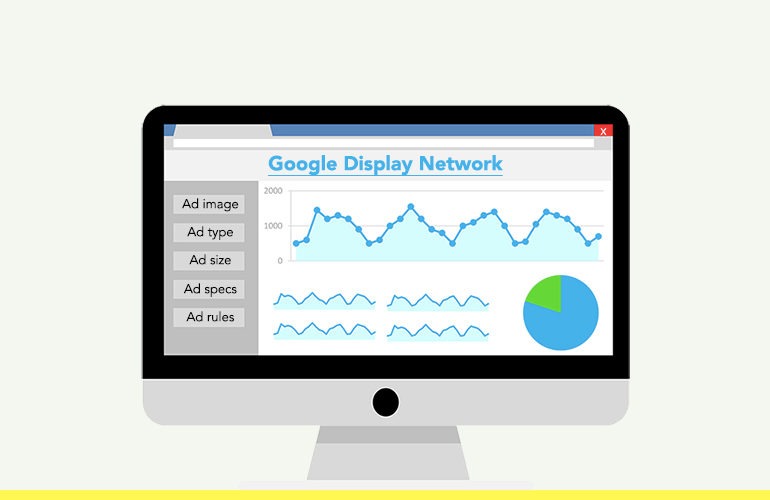Google Display Network provides a medium for advertisers to place their ads on websites where they can target their audience. It’s easy to use if one knows the fundamentals. But what’s in it for publishers if you ask?
For publishers, on whose websites these ads are placed, it’s better to know about the ad specifications and how they ultimately affect the overall look and feel of the website. If you (publisher) use AdSense to show ads, then you are a part of the Google network.
Hence, it’s important to know about both sides of the story and how ads specs affect your revenue generation. So without further ado, let’s start with Google Display Network ad specs and how can publishers leverage that information to make a profit.
1. What Are Google Display Ad Sizes?
This is something that worries both publishers and advertisers. Nobody actually knows which ad size is ideal. And there’s nothing fixed too.
It starts with the publishers making ad spaces (called digital inventory) on their web pages. Next, the advertisers look at the available spaces and design their ads accordingly. Here are some standard ad sizes supported:
| Ad Size | Name | Specs |
|---|---|---|
| 250x250 | Square | Generally placed on left or right sidebar of the page |
| 200x200 | Small Square | Generally placed on left or right sidebar of the page |
| 468x60 | Banner | Placed between articles or between breaks |
| 234x60 | Half Banner | Placed between articles or between breaks |
| 728x90 | Leaderboard | Featured on top of a webpage near the logo |
| 300x250 | Inline Rectangle | Placed within the content or at left-right sides of pages |
| 336x280 | Large Rectangle | Placed within the content or at left-right sides of pages |
| 120x600 | Skyscraper | Generally placed among sidebars and requires huge vertical space |
| 160x600 | Wide Skyscraper | Generally placed among the sidebars and requires huge vertical space |
| 300x600 | Half Page | Takes up almost half of the webpage’ great for awareness/branding campaigns |
| 970x90 | Large Leaderboard | Covers end to end horizontal space; generally placed at the top of page or between breaks |
| 320x50 | Mobile Leaderboard | Placed at the end of a webpage on mobile devices |
The ideal ad size depends on the website type and advertisers’ requirements. However, the top-performing Google network ad sizes are an inline rectangle (300×250), leaderboard (728×90), wide skyscraper (160×600), and mobile leaderboard (300×600). All these and 180×150 (small rectangle) are display ad standard sizes set by IAB.
For publishers, it’s recommended to go with standard ad sizes, as they are proven to drive better results. Also, ad spaces should be allotted in a way that they don’t block the main content. Otherwise, publishers would lose visitors and hence the interested advertisers.
2. Which Ad Format To Choose?
Google display advertisement mainly deal in three types: static, animated, and interactive.
Static ads are images with texts in JPG, PNG, and GIF (one loop) format. Animated ads can be of both GIF or SWF format. However, interactive ads, which need visitors’ involvement like hover on the ads, can only be uploaded in SWF format.
Choosing the ad type and format is an important part of the campaign. Animation and motion work fine to get visitors’ attention. Though, too much popping animation can annoy the visitors.
This is the reason, most publishers stick with static ads that have least chances of annoying the visitors. Furthermore, too many ads with loads of animation can affect page load time that ultimately affects the revenue too.
3. What Are Display Ad Content Specs For Publishers To Know?
Google Display Network has some strict rules when it comes to placing an ad to the websites. Here’re some general policies that Google (and publishers) ask advertisers need to follow:
- The image should be clear. A blurry or pixelated image is rejected right away.
- For advertisers, it’s advised to create ads resembling their brand or website. If visitors click on the ad, they should be redirected to a familiar web page.
- Advertisers are recommended not to imitate publisher’s webpage. Banner ads should be designed in the advertised brand’s persona.
- Do not create fake promising or hoax ads to trick visitors to click on them. Also, mimicking system warning or operating system error messages to get clicks is not an acceptable method to run ad campaigns.
If you look carefully, Google ads policy is designed to give a smooth visitors’ experience. This is obviously because visitors are the most important when it comes to revenue generation. Just like publishers, Google also doesn’t want to annoy visitors and hence these policies are formulated.
4. Is There Any Restricted Content For Ads?
There are certain things that can’t be shown in an ad because of being sensitive. Here’s some content type that Google doesn’t allow:
- Violent content or any text or image posing threat against an organization, person, group of people or a protected group distinguished by race or ethnic origin, color, national origin, religion, disability, sex, age, veteran status, sexual orientation, or gender identity.
- Alcoholic beverages, illegal drugs, and illegal chemical or their use,
- Adult content including escort services or profane content.
- Gambling (online or offline) or any services related to the same.
- Ads infected with virus, malware or similar threats.
5. Anything Else To Know?
Google display ad sizes should be under 150KB. Also, ads with white background and no borderlines are also restricted by Google. These Google Display Network ad specs are to make sure the ads look different from the rest of web content.
Also, using call-to-action is a good method to get leads. Generally, ads with text like ‘learn more!, shop now>>, get details…’ have a better chance of a conversion.
Testing bears better results. Just like any other campaign, ads also need to be tested in terms of format, type, color, size, position, design, and more. Not just for advertisers, publishers are also advised to run test ads. Google AdSense provides option to create test ad units and monitor them.
Finally, publishers need to know the look and feel of the ads that affect ad viewability. A good viewability score improves ad revenue. And a nicely designed ad has a chance of a good click-through rate and better CPM. All the insights kept in mind by publishers help them attract more advertisers and begin the ad revenue cycle again.

Shubham is a digital marketer with rich experience working in the advertisement technology industry. He has vast experience in the programmatic industry, driving business strategy and scaling functions including but not limited to growth and marketing, Operations, process optimization, and Sales.



![CTV vs OTT Advertising: Which one is Right Pick for Publishers? + [6 Bonus Strategies] Ott vs Ctv](png/featured-image-270x180.png)


